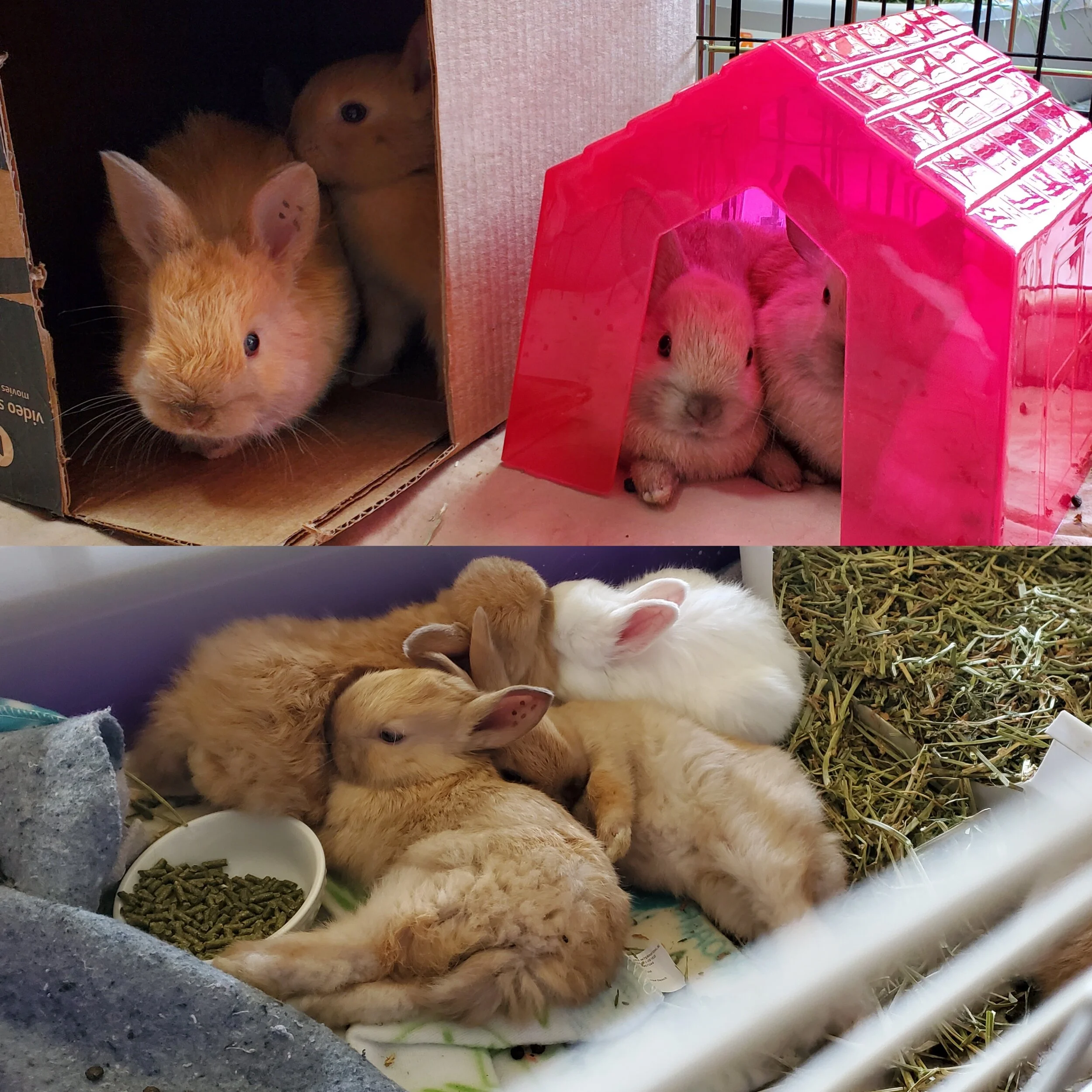
Caring For Baby Bunnies
Rabbit Advocates actively supports spaying and neutering all rabbits with help from a rabbit-savvy vet.
There are plenty of rescued rabbits who need forever homes. If you would like to care for a baby bunny, you can always foster-to-adopt with a reputable rescue! Rabbit Advocates often rescues female bunnies who are already pregnant and usually has litters in need of foster homes.
Preventing Bunny Pregnancies:
Check the sex of the rabbits with an expert, namely a veterinarian. Many people buy two “baby sisters” or “baby brothers” only to find a nest full of babies a few months later. Surprise! It can be very hard to definitively determine the sex of baby rabbits under 3 months old, and mistakes can have serious consequences. Male rabbits can be fertile by 2.5 months of age, and females by 3.5 months of age.
Keep female and male bunnies securely separated where they cannot touch each other. Bunnies are escape artists, especially when one or both are fertile. There are metal and fabric covers for exercise pens, and closet organizer cubes can help build barriers. It only takes a few seconds!
Spay and neuter all bunnies as soon as it is safe and recommended by your vet. Male bunnies can usually be neutered by 4-6 months old, assuming their testicles have fully descended and they’re at least 3lbs. Female rabbits need to wait until they are 5-6 months old. With small breeds under 3lbs such as dwarves, many vets prefer to wait until the bunny is nearly fully-grown at up to 9-12 months of age.
Watch out for rabbit fertility. Males can still make babies for up to 6 weeks after they get neutered! Female rabbits can get pregnant again immediately after giving birth. Many unintended litters have occurred when a freshly-neutered boy bunny was allowed to be near an intact girl bunny too soon, or when boy babies were left with a still-fertile mama past the 8-week point. After a spay, female rabbits are instantly infertile.
Confirm spay/neuter status. Rabbit Advocates spays/neuters all bunnies prior to adoption. Many people have acquired a rehomed rabbit who is supposedly already spayed/neutered only to discover that the bunny is intact. A veterinarian can confirm whether a bunny is actually spayed/neutered.
Schedule a vet visit. When in doubt, get help from professionals. Many of the signs of bunny pregnancy noted below can also occur when bunnies are sick or in pain.
Signs of Bunny Pregnancy:
Pulling fur. Pregnant bunnies often pull fur from their underbellies to form a nest and prepare to nurse the newborns.
Building a nest. Pregnant bunnies may start moving hay, blankets, and other items to keep their babies warm.
Eating more/less or a sudden change in food preferences. Pregnant bunnies need more food and nourishment during the pregnancy, but may nearly stop eating right before giving birth due to discomfort.
Hiding and/or resisting handling or other personality changes can be a sign of a mama bunny who is cautiously guarding her body and her space.
Feeling warm and/or breathing heavy. Pregnant bunnies may feel warmer and may breathe heavier due to the heat inside their bodies and raging hormones.
Expanding belly. As prey animals, rabbits have evolved to hide their vulnerabilities and many do not show any outward signs of pregnancy until the newborns arrive. Toward the end of a pregnancy, you may be able to feel the babies in the lower part of her belly near her private parts. The babies might feel a bit like big, hard grapes inside mama. Be careful, however, and defer to a veterinarian since many signs of pregnancy can also be signs of illness.
When Babies are Coming:
Female bunnies usually give birth overnight or in the early morning hours, and need to have a warm nesting box for the babies.
Mama needs to nurse her babies within 24 hours, and the babies should be plump and warm. Rabbit milk is very nourishing and mamas tend to nurse babies only twice per day for short periods.
Keep the babies together in a warm nest. The babies need to be in the same area where mama can nurse all of them at the same time.
Provide safe spaces for exploring babies. As they venture out of the nest, babies can get stuck between exercise pens and grid panels, injured, or even become lost. Start baby-proofing including using zip-ties to attach pieces of cardboard to the bottom of the enclosure. People often joke that baby bunnies are “liquid” because they can squeeze through tight spaces!
Make a plan. Be sure to have a plan for vet care. Line up appropriate homes in advance so that babies have a safe place to go when they leave the nest at 8 weeks old. Mamas can usually be safely spayed about 2 weeks after they finish nursing the babies for 8 weeks.
Basics of Domestic Baby Bunny Care
Caring for Orphans: Baby Avery's Story
Found a baby bunny without mama?
Watch this educational video featuring Rabbit Advocates Medical Team Lead, Mary Anne, and Baby Avery showing how to feed an orphaned baby bunny following The House Rabbit Society’s bunny milk replacement recipe.
Looking for a baby bunny replacement milk recipe?
How to Determine the Sex of Young Rabbits
by Rabbit Advocates Board Member Lori B
Rabbits reproduce, well, like rabbits! These cute vegan pets have a reputation for a reason, and that’s why Rabbit Advocates spays and neuters all bunnies prior to adoption. Especially with Easter right around the corner, many people will soon buy more than 1 baby bunny, and then find themselves with an unintentional litter by summertime. As always, we encourage everyone to adopt from a reputable rescue, and to start out as a foster provider if having a baby bunny (or two) is of paramount importance. There are already enough homeless rabbits and we do not need to make more. Plus, spaying and neutering decreases their lifetime risk of cancer. It also makes it easier for bunnies to be litter trained, have more freedom.
The House Rabbit Society and most rabbit-savvy vets recommend that male bunnies wait until they’re at least 4 months of age to get neutered, and females at least 5 months old. By then, anyone can have a pregnancy situation on their hands if they’re not careful. For smaller breeds under ~3lbs and malnourished or underweight buns, it may be necessary to wait even longer before they can safely have surgery. Yet these bunnies can still impregnate other rabbits or become pregnant.
In the rabbit rescue community, we frequently hear people say, “The breeder told me both bunnies were female”. Then the person wakes up one morning to find a newborn litter once their original bunnies are about 5 months old. Since rabbit gestation is only about 30-35 days long, and rabbits can get pregnant immediately after giving birth, the problem of accidental litters can quickly get out of control.
It is difficult to reliably determine the sex of most baby rabbits before they are about 6 weeks old and they may all appear to be female prior to about 5 weeks of age. Most people are selling or rehoming bunnies who have never been to a veterinarian and may not know their correct sex. Baby rabbits are also often sold when they are too young because they are adorable little babies, whereas they should stay with mama for 8 weeks. When baby bunnies are only one month old, most people cannot reliably tell the difference between female and male babies — anyone who tells you otherwise is probably selling something, like a rabbit, or two, or three.
To make matters worse, baby boys can be fertile with their mamas by as early as 2.5 months old. Even neutered males can still be fertile for up to 6 weeks after their alter surgery.
It’s challenging because it’s true that most bunnies prefer to live in pairs. But rabbits are highly fertile, hormonal, and territorial creatures, especially when they are not yet “fixed”. It is much easier to have a litter-trained house rabbit (or pair) once everybunny has had their spay or neuter.
Taco or Burrito?
To attempt to determine the sex of a young rabbit, it is usually necessary to have one person hold the bunny with both hands while another person checks its private parts. One person usually needs to stabilize the bunny and help open the legs, while the other person gently presses on the genital opening to see its shape. Bunnies are known for their soft fluffy fur and all the floof can make it hard to see the genital area. In younger buns, it is usually essential to press back on the genital area to see it more clearly.
From about 6-12 weeks of age, the following characteristics are usually noted on young female rabbits. In females, their externally-visible opening is more like the shape of taco. It is not a full/complete circle. In young females who are not yet sexually mature, their external genital opening often appears to be very pale pink in color. As the females mature, the coloring becomes a darker shade of pink.
In males, usually you can start to see a “spout” by about 6-8 weeks old, joking referred to as a “burrito” because the opening is a complete circle. In males over 3.5 months of age, it should be possible to see testicles which initially look like pink cannellini beans. Some young males can “retract” their testicles making it harder to determine the sex (and approximate age) of the bunny, so it is always worth looking at their external genital opening as well. You may be able to gently palpate and feel undescended or retracted testicles under the skin next to their opening.
Rabbits are notorious tricksters so always check, re-check, and get help from a veterinary professional.
Disclaimer:
This guidance is not intended to replace veterinary care from a licensed professional. The best way to keep your rabbit(s) happy and healthy is to see a bunny-savvy vet regularly.
Resources:
Rabbits all over… when reproduction gets out of control: Rabbit overpopulation. MediRabbit. http://www.medirabbit.com/EN/Uro_gen_diseases/Repro/Overpop.htm
Reproductive tract of the female rabbit, Esther van Praag, Ph.D., MediRabbit. http://www.medirabbit.com/EN/Uro_gen_diseases/Fem_rabbit/Fem_en.htm
Male reproductive tract and orchidectomy, Esther van Praag, Ph.D., MediRabbit. http://www.medirabbit.com/EN/Uro_gen_diseases/castration/Castra/Castration.htm
How to Determine a Rabbit's Sex - House Rabbit Society https://rabbit.org/how-to-determine-a-rabbits-sex/
Extreme Rabbit rescue-Mama Steve and Babies
A community member Genifer discovered that an orange bunny “Mama Steve” gave birth to a litter of babies under her porch, and contacted Rabbit Advocates for help. This is the video footage of our rescue team volunteer Nathaniel rescuing the last baby. Since the filming of this footage, Mama Steve had given birth to a second litter of 9 additional babies! Mama and 15 babies are safe and being fostered by Genifer and her family. Read the full story on the Rabbit Advocates April 2021 newsletter.




